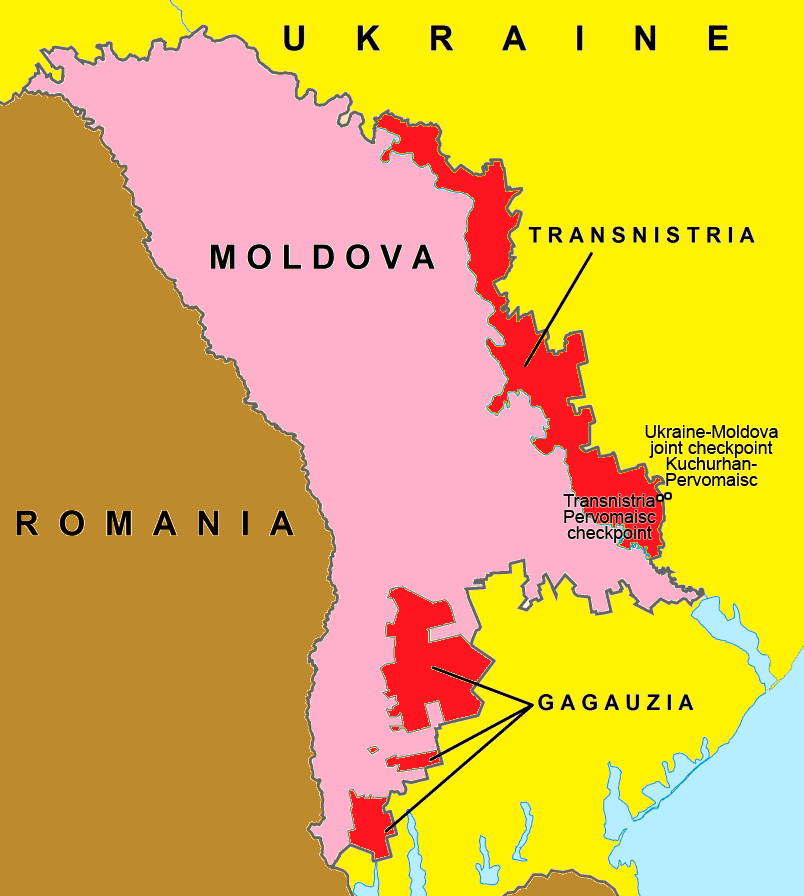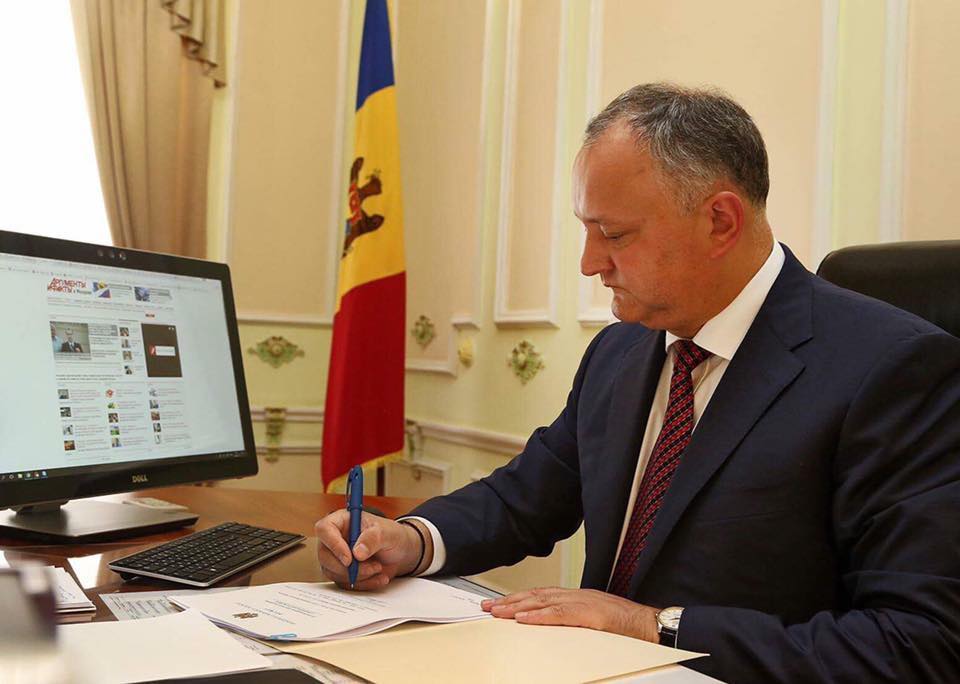The breakaway Moldovan region of Transnistria is not recognized by any country as an independent state. Even Russia, which is keeping the conflict in Moldova frozen, didn't recognize Transnistria. The Moldovan government has no control of the eastern region for more than 25 years.
The Moldova–Ukraine inland border is 1222 km long. Transnistria controls 454 km of the Moldovan border with Ukraine. On the Ukrainian border, 31 border crossing points operate in Moldova's government-controlled territory, 14 more were established by Transnistria.
However, this year Ukraine and Moldova have found a strategy for Moldova to regain control of its border, and the strategy may work. The first joint checkpoint has been opened on Ukrainian territory bordering on the Transnistrian region. Twelve more to be open in the future.

Joint checkpoints
On 17 July, Ukraine's President Petro Poroshenko and Prime Minister of Moldova Pavel Filip opened the joint crossing point “Kuchurhan-Pervomaisc” on the Ukraine-Moldova border in Odesa Oblast. Ukrainian and Moldovan border guards and customs officials have started to maintain the joint customs and border crossing control. Representatives of EUBAM (the EU Border Assistance Mission to Moldova and Ukraine) work together with national border services at the checkpoint.
The checkpoint has been opened on the highway, connecting the capital city of Transnistria, Tiraspol with Odesa, the biggest Ukrainian city in the region. According to PM Filip, more than 70% of all trade operations of Transnistria had earlier been conducted via “Kuchurhan-Pervomaisc” border crossing point.
The Moldovan Prime Minister believes that "This common crossing point comes first and foremost to the interest and comfort of the citizens of the region, as well as to the interest of the economic agents."
According to Poroshenko, Ukraine is willing not just to help Moldova to regain control of its border, but "to facilitate the restoration of Moldova’s territorial integrity and sovereignty."
Pro-Russian President of Moldova Igor Dodon welcomed the establishment of a joint Ukrainian-Moldovan checkpoint, stressing that one of the attributes of preserving Moldova's territorial integrity is its consistent border.
The Transnistrian authorities see Moldova's border control of the region as a threat for the local economy of the enclave. So-called Transnistrian prime minister Aleksandr Martynov said: "Establishing the joint customs checkpoint is a shining example of an action not in favor of the people."
The Russia's Foreign Ministry, of course, fully supports Transnistria and calls opening of joint checkpoints "elements of external pressure" referring to the EU funding involved in the process.
Ukraine and Moldova are also going to complete demarcation of the Transnistrian area of the Ukraine-Moldova border.
In April, Moldova's pro-European government signed a deal to buy electricity from a Ukrainian company, DTEK Trading, owned by Ukrainian tycoon Rinat Akhmetov. The Cuciurgan power station, situated in the south of the Transnistria region, produces more than 80% of Moldova's electricity. The ministry said the Ukrainian provider had offered a better price than the power plant in Cuciurgan, Transnistria, which operates under Russian Inter Rao.
The Ukraine-Moldova Intergovernmental Commission for Trade-Economic Cooperation will hold its session in September. “This, inter alia, concerns the supply of Ukrainian electricity to Moldova,” President Poroshenko highlighted at the briefing after the opening ceremony of the crossing point “Kuchurhan-Pervomaisc.” This step may facilitate the Moldova's energy independence from its breakaway region.
The blockade narrative
Earlier in June, the so-called Pridnestrovian People’s Forum (PPF) sent Russian President Vladimir Putin a request asking to prevent the “intensification of the blockade of Transnistria by Moldova and Ukraine.” The statement alleged that Moldovan border control of the Transnistrian part of the state border could lead to an annual loss of $40 mn for Transnistria’s economy, approximately one fifth of the consolidated budget. Nearly 10% of the residents of the region would be deprived of work and means of existence, according to the statement.
On 7 July, Russia's State Duma adopted a statement
calling on Ukraine and Moldova to "abandon any forms of pressure on Transnistria and actions of arranging its blockade" claiming that joint Moldova-Ukraine border checkpoints have already been open on the Transnistrian section of the Moldova-Ukraine border. The Duma states that a peacemaking mission in Transnistria has no alternative and claims that the 5+2 format of the Transnistrian conflicts' settlement "proved its high efficiency in keeping peace and security in the region over 15 years."
A few days later, the Ukraine's Foreign Ministry called the statement of the Duma groundless accusations.
Moldovan PM Pavel Filip commented on allegations that Ukraine and Moldova have been trying to establish an "economic blockade" over the Transnistrian region, "We make a very clear difference between the so-called leaders in the Transnistrian region and our citizens living in this region. Perhaps the present event is not to the liking of Tiraspol leaders, but it is to the citizens’ benefit," stressed Filip at a briefing at the opening ceremony of the “Kuchurhan-Pervomaisc” border checkpoint.
The population of Moldova is about 3.5 million. Russia's State Duma claims that more than 200,000 residents of the near 500,000 population of the Transnistrian region are the Russian citizens. The issuing of Russian passports on the occupied territories was the Russian common practice in Moldova's Transnistria, as well as in Georgia's two occupied regions of Abkhazia and South Ossetia. In 2008, then Russian President Dmitri Medvedev called the protection of the Russian citizens a causa formalis for an aggressive war against Georgia. Moldova may face the same scenario if the situation deteriorates. However, Russia has no possibility to supply its troops in the Transnistrian region having no common borders with Russia.
The Russian and Transnistrian allegations of the Ukrainian "economic blockade" over Transnistria emerged in 2015 as Ukraine canceled the agreement that allowed Russia to supply its 1,200-1,500 troops stationed in Transnistria through Ukrainian territory. The Ukrainian route was the only way by which Russian forces in Transnistria could be reached by land.
Russian media accused Moldova in the alleged blockade of Transnistria even back in 2010.
Will Moldova take control of Transnistria?
Earlier in July, pro-Russian Moldovan president Igor Dodon opposed a statement of so-called Transnistrian president Vadim Krasnoselsky who once again repeated
the standard Transnistrian mantra that there is no other option for Moldova than to recognize his breakaway republic. Dodon said, "We must reintegrate the country. And we will do that. I am confident it will be done in the next few years, regardless of what some leaders of Moldovan regions might say… No doubt, the country will reunite."
Russian media Gazeta.ru reported that the flight of the former Transnistrian president Yevgeny Shevchuk to Chisinau coming after Moldova’s erection of customs posts on Ukrainian territory on the border of the unrecognized republic and earlier Chisinau’s expulsion of five Russian diplomats has sparked fears in Tiraspol and Moscow that Russia is “losing control” of the situation there.
On 20 July, the Parliament of Moldova approved a law changing the proportional electoral system with a mixed scheme which will let voters cast their ballot for constituency candidates as well as party lists. Lawmakers voted 74-3 to adopt the changes. Earlier the Venice Commission, a body which rules on rights and democracy disputes in Europe, has raised concerns, saying individual constituency MPs could come under pressure from business interests. Thousands rallied outside Parliament as the as parliamentarians debated the legislation.
President Dodon welcomed the legislation, which also includes voting for candidates in special districts of the pro-Russian Transnistrian region.

Moldova holds its next parliamentary elections in 2018. The pro-European Democratic Party's coalition will face a tough contest with Dodon's pro-Russian Socialists. If Democrats lose, the parliamentary republic would have a pro-Russian government.
President Dodon's repeated statements on reintegrating of Moldova may just disclose the Russian plans for the Transnistrian region. Hoping for full control of whole Moldova, Russia may consider closing the 25-year-long project Transnistria to use entire Moldova as its outpost on Europe's doorstep instead.
- Russia-backed Transnistria ("the Pridnestrovian Moldavan Republic," PMR) is a landlocked self-proclaimed puppet state situated between the Dniester River and the Moldovan border with Ukraine.
- No state recognized the Transnistrian independence. Only three other post-Soviet zones of frozen conflicts, Abkhazia, South Ossetia and Nagorno-Karabakh, recognized PMR as an independent nation.
- The Transnistrian conflict began in 1990 when the several eastern provinces seceded from the Soviet Republic of Moldova for fear of Moldova's potential unification with Romania.
- In March 1992, tensions escalated into the military conflict. Russian and Ukrainian mercenaries and volunteers participated in the conflict opposing the Moldovan government. Russian troops, the former Soviet 14th Guards Army, entered the conflict in its final stage, opening artillery fire against Moldovan forces.
- The military conflict ended in a cease-fire brokered by Russia declared on 21 July 1992. However, the conflict remains unresolved by now. The Russian military contingent remains deployed in the breakaway region.
- Since 2005, the talks on the Transnistria conflict's settlement have been held in the 5+2 format (OSCE, Russia, Ukraine, EU, US + Moldova, Transnistria).
- Transnistria issues a local version of the Russian ruble and prints its own domestic identity papers.
- Russia maintains a 1,200-strong military force in the region despite Moldova's repeated calls for it to be withdrawn and replaced with international peacekeepers.
Read more:
- Russian diplomats Chisinau expelled reportedly recruited Gagauz to fight in Ukraine
- Russian troops unconstitutionally occupy Moldovan territory – Constitutional Court
- European Court of Human Rights ruled Russia responsible for actions of Transnistria
- Transnistria. Why Russia should leave the occupied territories
- Russian and foreign volunteers in Ukraine: lost idealism and ennui
- Russia’s plans to create new “republics” in southwestern Ukraine
- Russia determined to expand influence over former Soviet colonies
- Bulgaria, Moldova elect pro-Russian presidents
- The 75 Russian military units at war in Ukraine
- Why Ukraine must avoid the Transnistrian scenario
- Moldova – Ukraine’s problematic neighbor or partner on the road to the EU?
- Bulgaria, Moldova elect pro-Russian presidents
- Transnistria frozen conflict zone recognizes Russian tricolor as second “national” flag
- Stages of Russian occupation in a nutshell

